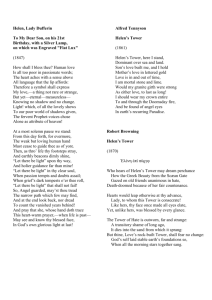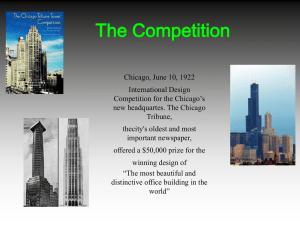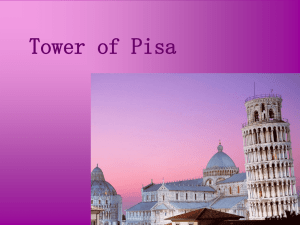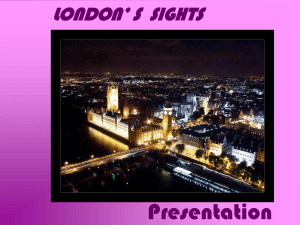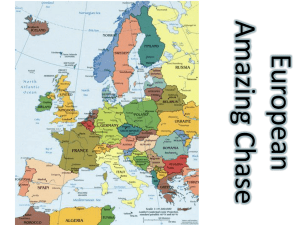Three on a Tower Presentation
advertisement
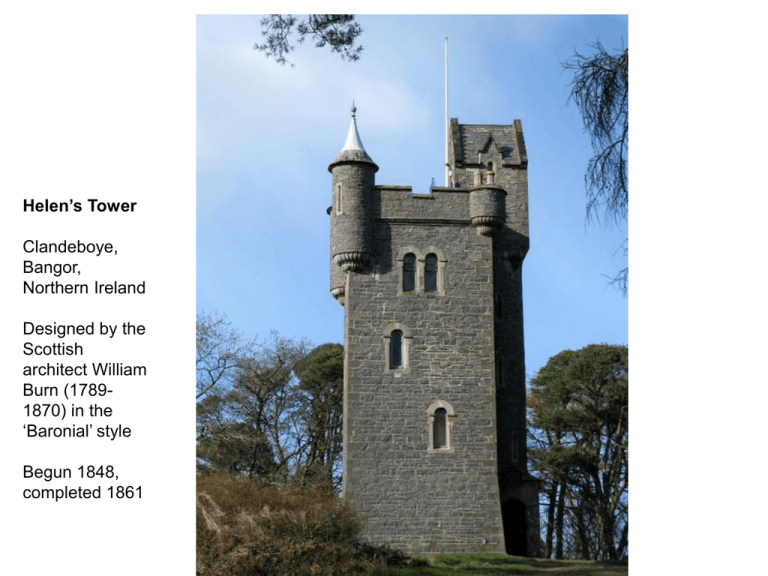
Helen’s Tower Clandeboye, Bangor, Northern Ireland Designed by the Scottish architect William Burn (17891870) in the ‘Baronial’ style Begun 1848, completed 1861 Alfred Tennyson, ‘Helen’s Tower’ (1861) Helen’s Tower, here I stand, Dominant over sea and land. Son’s love built me, and I hold Mother’s love engraved in gold. Love is in and out of time, I am mortal stone and lime. Would my granite girth were strong As either love, to last as long! I should wear my crown entire To and thro’ the Doomsday fire, And be found of angel eyes In earth’s recurring Paradise. 4. engraved in gold] in lettered gold (1884) 5-6.] These lines were already present in two of the three MSS which Tennyson sent to Lord Dufferin in Oct. 1861, but do not appear on the original plate; they were added to the published text in 1884. Helen, Lady Dufferin (1807-67) Frontispiece to Songs, Poems, & Verses by Helen, Lady Dufferin London: John Murray, 1894 Helen Blackwood (Lady Dufferin) To My Dear Son, on his 21st Birthday, with a Silver Lamp, on which was Engraved “Fiat Lux” (1847) How shall I bless thee? Human love Is all too poor in passionate words; The heart aches with a sense above All language that the lip affords: Therefore a symbol shall express My love,—a thing not rare or strange But yet—eternal—measureless— Knowing no shadow and no change. Light! which, of all the lovely shows To our poor world of shadows given, The fervent Prophet-voices chose Alone as attribute of heaven! At a most solemn pause we stand: From this day forth, for evermore, The weak but loving human hand Must cease to guide thee as of yore. Then, as thro’ life thy footsteps stray, And earthly beacons dimly shine, “Let there be light” upon thy way, And holier guidance far than mine! “Let there be light” in thy clear soul, When passion tempts and doubts assail; When grief’s dark tempests o’er thee roll, “Let there be light” that shall not fail! So, Angel guarded, may’st thou tread The narrow path which few may find, And at the end look back, nor dread To count the vanished years behind! And pray that she, whose hand doth trace This heart-warm prayer,—when life is past— May see and know thy blessed face, In God’s own glorious light at last! BROWNING AND LADY DUFFERIN I should be sorry, even were I able, to rival the beautiful verses which are fitly engraved on gold: here is the best I can do, however. You must not forget that I enjoyed—though too rarely—the privilege of seeing the face I speak of,—and I have in mind one especial and gracious piece of kindness shown to a little Italian boy of my acquaintance. Letter to Lord Dufferin enclosing ‘Helen’s Tower’, 27 April 1870 Just think of little Alessandro, the red-headed boy Peni liked so to play with, coming here on a visit,—to his grandmother who lives at Highgate! Letter to Isa Blagden, 19 June 1862 There was no compliment in what I said about the singularly love-inducing lady. Letter to F. J. Furnivall, 24 Dec. 1883 I knew the lady and have not flattered her. Letter to Mrs Bronson [Katharine de Kay Bronson] 27 Jan. 1884 Robert Browning, ‘Helen’s Tower’ (1870) Έλένη έπί πύϱγφ Who hears of Helen’s Tower may dream perchance How the Greek Beauty from the Scæan Gate Gazed on old friends unanimous in hate, Death-doomed because of her fair countenance. Hearts would leap otherwise at thy advance, Lady, to whom this Tower is consecrate! Like hers, thy face once made all eyes elate, Yet, unlike hers, was blessed by every glance. The Tower of Hate is outworn, far and strange: A transitory shame of long ago, It dies into the sand from which it sprang: But thine, Love’s rock-built Tower, shall fear no change: God’s self laid stable earth’s foundations so, When all the morning stars together sang. Mr. Tennyson having made public the lines which he wrote, at Lord Dufferin’s request, for “Helen’s Tower,” erected by him to the memory of his late mother ... Mr. Browning has consented to the publication of his verses on the same occasion, and written at the like request, made to him after it had been made to Mr. Tennyson. The difference in treatment of the same subject by the two poets will, we are sure, interest our readers. Pall Mall Gazette, 28 Dec. 1883, p. 2 (almost certainly written by, or heavily reliant on, F. J. Furnivall) Thoor Ballylee, near Gort, Co. Galway Two images of the ‘winding stair’ in Thoor Ballylee Sources: left http://blogs.haverford.edu/celticfringe/files/2014/02/thoor-ballylee3.jpg right: http://www.facstaff.bucknell.edu/rickard/Coole.html [untitled inscription] I, the poet William Yeats, With old millboards and sea-green slates, And smithy work from the Gort forge Restored this tower for my wife George. And may these characters remain When all is ruin once again. To be Carved on a Stone at Thoor Ballylee I, the poet William Yeats, With old mill boards and sea-green slates, And smithy work from the Gort forge, Restored this tower for my wife George; And may these characters remain When all is ruin once again. [concluding poem in Michael Robartes and the Dancer, 1921; text from Collected Poems, 1933] A Meditation in Time of Civil War For one throb of the artery, While on that old grey stone I sat Under the old wind-broken tree, I knew that One was animate, Mankind inanimate phantasy. To be Carved on a Stone at Thoor Ballylee I, the poet William Yeats, With old mill boards and sea-green slates, And smithy work from the Gort forge, Restored this tower for my wife George. And may these characters remain When all is ruin once again. Sequence of poems at end of Michael Robartes and the Dancer 5* hotels are all well and good but if you want a break with a difference, in which you can live out your Rapunzel fantasies, then you need somewhere a bit more unique. Helen's Tower in the Clandeboye Estate, Bangor will be perfect. . . . Inside you'll find a double bedroom, shower room, fully-equipped kitchen, living room and a reading room - all of which have been restored where appropriate to give you a taste of how the tower would have stood following its completion in October 1861. During that time the tower has even inspired works of poetry. Helen’s Tower and the Ulster Tower at Thiepval Inside the Ulster Tower at Thiepval. The inscription running around the four walls reads: “Helen’s Tower, here I stand / Dominant over sea and land. / Sons’ love built me and I hold / Ulster’s love in lettered gold”—adapting Tennyson’s poem by converting singular Son’s to plural Sons’ and substituting ‘Ulster’s love’ for ‘Mother’s love’.
